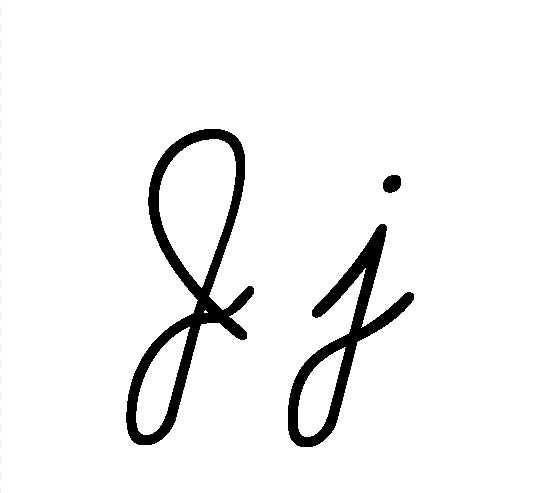
Are you interested in learning how to write a cursive capital J? Read on to find out not only how to write a cursive capital J, but learn some interesting facts about cursive. You can write a cursive capital J by carrying out the following steps.

Photo: Alma Cebrian, URL: https://commons.wikimedia.org/wiki/File:J_cursiva.gif, CC-BY-SA 3.0
Pick a point to start drawing the J at and then make a semicircle that arcs upwards and towards the left before flowing back right. After you draw the end of the semicircle or the crest of the J draw a fairly straight line that is angled just slightly down and to the left, following it back to the original point you drew and down aways. You will now draw a second semicircle that will arc up and to left and then move back right headed upwards, intersecting the original semicircle on the way and finishing the J by moving through the straight line that you drew earlier. You should know that there are several different ways to draw a cursive J, depending on the font used, but you can look up images of a cursive J to see some of the different ways it can be drawn.
The How And Why Of Cursive
The usual rationale for writing cursive is that it makes writing faster and easier because unlike printing, you don’t need to lift your writing tool as many times. Cursive letters are joined together in a flowing format, and the act of joining letters together enables faster writing. Certain variations of cursive may include more lifts and spaces, but cursive is generally joined together. Cursive can also be called script or longhand. Looped cursive, ligature cursive, and italic cursive are several subtypes of cursive.

Photo: John Mason Neale, URL: https://en.wikipedia.org/wiki/File:Looped_cursive_sample.jpg, Public Domain
The term cursive is derived from medieval Latin, from the term “corsivo” which means “to run”, or “running”. Various societies have used some form of connected letter systems throughout history. The Arabic language prominently used connected script, and so did some forms of Roman writing. In Western Europe during the late 16th century to mid-17th century, cursive began to emerge as the new standard for writing in the English language. The British Empire during the 17th and 18th centuries saw cursive become even more popular. Americans have used cursive since the days of the American colonies, and the form of cursive used today in the United States was well-established by the middle of the 19th century.
Ligature cursive is a form of cursive that connects the beginning and ending letters of words together with lines, with the result being that one barely has to lift their writing tool between letters. Italic cursive is a form of cursive that uses almost no looped joins. There are no joins between the letters G, Q, J, or Y in Italic cursive. The term italic cursive comes from the fact that this type of cursive was used in Italy during the Renaissance. This is different from Italic type characters, with Italic in that context meeting simply that the letters are slanted. Looped cursive is what most people think of when they hear the term cursive, and it has descenders or ascenders that have their own unique loops which help join letters together.
There are various types of cursive scripts, different methods of writing cursive, different systems of standardized letters for cursive writing. The most commonly used script in the United States is the D’Nealian script. This style of writing is used for teaching both cursive and print writing. The D’Nealian script is derived from a different method of teaching, the Palmer method. The D’Nealian writing style is intended to make learning both cursive handwriting and manuscript writing easier, and it was developed by primary school teacher Donald Thurber in 1978. Thurber found that prior methods of teaching children with other script styles made transitioning to learn cursive difficult, and wanted to create a system of teaching basic handwriting skills to children which was easier for children to learn. It is somewhat up for debate whether or not the D’Nealian cursive instruction system actually makes learning cursive easier, though a 1993 research review conducted by Steve Graham found no credible evidence that the system made a substantial difference in the writing of children over the long term.
Technology has continuously affected the use of cursive. The decline of cursive handwriting was driven in part by the invention of the ballpoint pen. One of the reasons for using cursive was that cursive facilitated writing with ink quills, but as ballpoint pens became more ubiquitous and reliable, producing ink that wouldn’t smudge, the necessity of cursive began to decline. This decline was driven further by the creation of the typewriter, keyboard, and computer.
Is Teaching Cursive Necessary?
Since the late 50s and early 1960s, schools across the United States have taught cursive to their students. However, cursive is argued to be an unnecessary skill and a waste of instruction time in the 21st century. Many teachers and school districts refer to cursive as a dying art. A study conducted in 2007 found that around half of all second graders and approximately 90% of all third graders across the country had been taught cursive. Yet despite the widespread teaching of cursive over a decade ago, only 15% of students at that time wrote their answers to the SAT in cursive. In the intervening years, as digital communication has grown in popularity, and computers and smartphones have become widespread, states like Indiana and Hawaii have chosen to no longer mandate the teaching of cursive in their school curriculums. Instead, the states have chosen to focus on keyboard proficiency.
While cursive maybe dying out in school districts in the 21st century, historians, teachers, and scientists still argue for its preservation. This is because many documents are written in cursive, including important historical documents. The inability to read cursive means that it would be difficult for historians to interpret important documents in an untranslated form. While the usefulness of learning cursive for historians is, in general, an accepted point, the debate regarding the utility of teaching cursive to students in the 21st century rages on, and school districts around the United States seem to be reducing their investment in the study of cursive.
Since 2010, 45 different states have adopted the common core standards of education, and these common core standards do not mandate the instruction of cursive, rather they leave it up to individual states. It seems that many states are choosing to forgo teaching cursive, with a report done by the Miami-Dade public school system finding that instruction in cursive has been slowly declining across the United States since the 1970s. Other countries such as Finland have dropped cursive handwriting in favor of typing courses.
Some educators have argued that cursive is still important, because it helps the development of concise, clear, legible handwriting in general. It is also argued that neat handwritten is worth pursuing because legible script helps students develop their own language skills, teaching them to read and write faster. Some research has supported the idea that writing things down, in contrast to typing them, improve both a student’s conceptual understanding and the recall of the material. Studies that have compared students who take notes by hand to those who take notes on a computer have found that those who did note taking by hand had better factual recall and better understanding of the material overall.
However, despite this evidence, it isn’t entirely clear that the act of writing in cursive is what improves comprehension of the material. It could easily be that the act of simply writing the information down in a physical format improves understanding, with the type of writing inconsequential. Arguments against teaching cursive also challenge the idea that cursive actually enhances one’s motor skills or improves cognition, claiming that these perceived benefits are actually just confirmation bias – a desire to attribute perceived gains in motor skill or cognition to cursive simply because it looks better.
Other criticisms of cursive include the fact that many studies which purport to display the benefits of cursive have been misrepresented or misinterpreted.
On the other hand, there is some evidence that learning cursive could help teach students to read and write better, this is particularly true for students with disabilities, as some research suggests teaching cursive could help treat dyslexia.
Regardless of how you feel about the necessity of cursive, the way to get better at cursive is to practice. You can start out by procuring a list of cursive letters. A list of cursive letters can guide you in practicing all the different letters daily until you are proficient with the writing style and can easily join the letters together. Just as with any skill, practice refines your skill set and help your penmanship improve.








